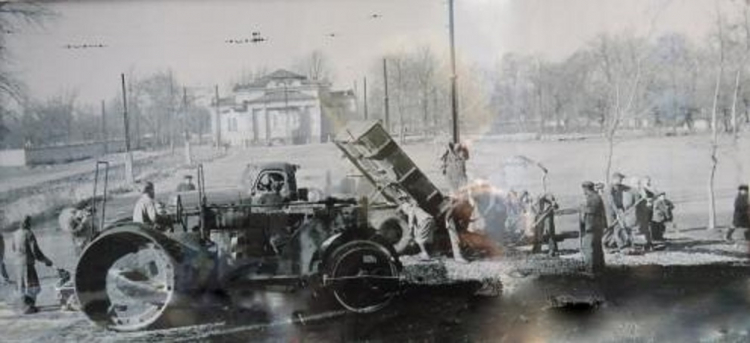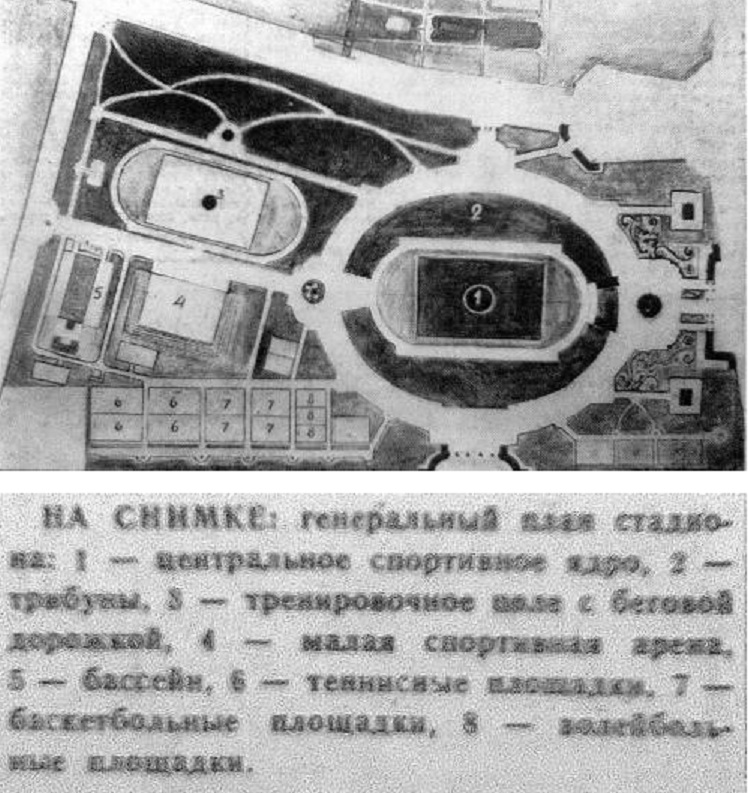THE MAIN ENTRANCE OF THE CAPITAL
The first passenger train arrived here at the first one-story building of the station on May 25, 1931. The newspaper "Soviet Kyrgyzstan" wrote at that time: "On May 25, at 6:45 a.m., the first ceremonial train departed from the Pishpek station towards the newly constructed Frunze station. Exactly 35 minutes later... the passenger train left not from Pishpek, but from the Frunze station to Tashkent." And seven years later, on May 1, 1938, the grand opening of the new station building, designed by Kharkov architect Limar, took place. The main facade of the station with the grand staircase faces the square in front of the station. The platform is located on the southern side. Access to the station and the platform is provided not only through the building but also via staircases on the sides of the building. The interior design of the station involved artist A. I. Ignatiev, the People's Artist of the Kyrgyz SSR, Hungarian sculptor Laszlo Mesaros, and artists Bogdanov and Kataevsky. In the same year, the square in front of the station was paved and later asphalted. A park was created next to the square.
In the 1960s, three-story buildings were erected on the square in front of the station, including the "Tian-Shan" hotel, later renamed "Ala-Too" (architect I. Lyublinsky) and the Geology Department of the Kyrgyz SSR (architect A. Albansky).
From the square in front of the station stretches a wide avenue, over one hundred meters long, named after F. E. Dzerzhinsky, with a green zone in the center. The park area features oaks, elms, birches, acacias, pines, and spruces, with flowerbeds arranged. In the late 1950s and 1960s, evergreen thuja were planted on both sides of the roadway, giving the avenue an incredibly beautiful appearance.
Dzerzhinsky Avenue is one of the most beautiful streets in the city. It is essentially the main entrance to the capital.
The original name, Boulevard Street, was given before the October Revolution. The first plantings of the boulevard began in the late 19th century and were carried out on the section from Sudeyskaya Street to Tashkent Street. On Forest Day, April 4, 1902, at the initiative of the head of the Pishpek Agricultural School, agronomist P. P. Ivanov, director of the city school K. F. Svirchevsky, and forester I. V. Tsarunov, the plantings were extended approximately to the current Engels Street.
In the 1930s, the section from Frunze Street to Kirov Street and from Engels Street to the station square was landscaped. To irrigate the trees in the early 20th century, the so-called "state ditch" was constructed along the plantings, which still exists today.
Before the revolution, the street was primarily built up with small civil buildings and residential houses of the local nobility - merchants, officials, and townspeople. Here were located bookstores and stationery shops of I. F. Terentyev, sausage products of G. F. Shott, and agricultural tools of D. A. Kandaurov. At the corner of Sudeyskaya Street (Frunze), where the State Planning Committee of the republic was located, was the forester of the Pishpek district.
After the October Revolution, at the end of 1924, Boulevard Street received a new name - Komsomolskaya. But it was called that for a short time. In 1927, it was renamed Dzerzhinsky Street, or as it was long called, Dzerzhinsky Boulevard. Since 1970, the street has been designated as an avenue.
The first substantial building on the street was the State Bank building, erected in 1926 (architect A. P. Zenkov), between Frunze and Alamedinskaya Streets (Ivanitsyna). It has not lost its distinctive beauty to this day. In the 1930s, buildings for a kitchen factory (1931), the House of Printing (1931), a teacher training college (1936), schools, and several good two-story residential buildings were constructed here. The kitchen factory building housed a gymnastics club from 1936 to 1937, and later during the Great Patriotic War and afterward, the Kyrgyz State Philharmonic named after Toktogul and a consumer goods store. In the 1950s, the left part of the building housed the republican puppet theater, organized in 1938 (this building has since been demolished).
The construction of the House of Printing was truly a revolution in the cultural construction of the republic. Since 1931, it housed the publishing house "Kyzyl Kyrgyzstan," "Komsomolets of Kyrgyzstan," "Leninchil Zhas," "Kyrgyz Telegraph Agency (KyrTag)." Currently, the printing house publishes republican newspapers and magazines such as "Communist," "Propagandist and Agitator of Kyrgyzstan," "Chalkan," "Kyrgyzstan Ailadary," "Herald of Time," and "Zaman Zharchysy." Since March 1, 1969, the newspaper "Pravda" has also been printed here.
In the building of the teacher training college, since 1943, the Kyrgyz branch of the Academy of Sciences of the USSR with the Institute of Geology and the Central Scientific Library was located. The first chairman of the branch, academician, Hero of Socialist Labor Konstantin Ivanovich Skryabin worked here, later becoming an honorary academician of the Academy of Sciences of the Kyrgyz SSR, as indicated by the memorial plaque affixed to the building.
In the 1940s, a two-story building for the telegraph with a telephone station for 4,000 numbers and the House of the Prosecutor's Office (architect V. Veryuzhsky) were put into operation.
By the way, here on this street, for the first time in the city, cobblestone pavement was laid; on May 1, 1932, the section from Frunze station to Dubovy Park (eastern side) was opened for vehicle traffic.
In 1938, the roadway of the street was asphalted. Later, granite curbs were laid along the edges. In 1946, decorative lighting poles were installed, which were replaced in 1978 with new, modern ones.
In the post-war period, the street continued to be improved and developed. Multi-story residential buildings with shops on the first floors sprang up. In 1967, a five-story building for the State Planning Committee was constructed, and in 1969, a modern four-story building for the City Party Committee was erected at the corner of Kirov Street (architect A. Golovanyev). In 1976, builders gifted the city a five-story hotel "Pishpek" (architect V. V. Lysenko). In 1977, a nine-story building for the computing center (architect V. Nikulina) was erected next to the State Planning Committee building. The republican scientific and technical library was also located in this building.
Dzerzhinsky Avenue is rich in monuments and memorial sites. In the square at the station, on October 25, 1967, a monument to our fellow countryman, revolutionary and commander of the Civil War Mikhail Vasilyevich Frunze was ceremonially opened (sculptors A. Posyado, L. Dubinovsky, architects A. Isaev, G. Kutateladze). On a high pedestal, faced with polished red granite, the inscription reads: "M. V. Frunze from the Communist Party of Kyrgyzstan and the workers of the Kyrgyz SSR." In the center of the boulevard, at the intersection with Engels Street, on the 30th anniversary of the October Revolution, on November 5, 1947, a bust monument to Kyrgyz poet and playwright Joombart Bokonbaev (1910-1944) was opened (sculptor S. M. Manuilova, architect V. Veryuzhsky).
In September 1975, above Lenin Avenue, a bust carved from solid pink granite was unveiled to the twice Hero of Socialist Labor, innovator of collective farm production, sugar beet grower Suurakan Kainazarova, a link leader of the "Druzhba" collective farm in the Sokuluk district. Near Dubovy Park, at the intersection with Pushkin Street, on January 22, 1948, a monument to the organizer of the Communist Party and creator of the Soviet state V. I. Lenin was opened (sculptor N. Neroda, architect V. Veryuzhsky). The monument is an obelisk topped with a full-length figure of the leader. The height of the monument is 13 meters.
Due to the fact that in October 1984, a new majestic monument to V. I. Lenin was unveiled in the new main square of the city, this monument was removed. In its place, in 1987, a monument to the knight of the revolution F. E. Dzerzhinsky, after whom the avenue is named, was erected (sculptor T. Sadykov). Behind the park, at the intersection with Ivanitsyna Street, in November 1967, a monument-bust to the first leader of the Pishpek Bolshevik organization Alexei Illarionovich Ivanitsyn was unveiled (sculptor N. Lodyagin).
And now about the memorial sites of the avenue. We will also start from the station. On the eastern side of the avenue, in the house at the corner of Bokonbaev Street, there are two memorial plaques. One of them reads: "In this house from 1947 to December 1978 lived the writer K. Malikov." Kubanychbek Imanalievich Malikov (1911-1978) was a poet and playwright, a distinguished figure in the arts and the people's poet of the Kyrgyz SSR; he is the author of 60 books of poetry, prose, and drama; the second plaque states: "In this house from 1952 to 1978 lived the People's Artist of the USSR A. Maldybaev." The name of composer Abdylas Maldybaev (1906-1978) is known to every music lover and theatergoer. His songs are sung throughout the republic. He is one of the authors of the music for the Anthem of the Kyrgyz SSR.
On house No. 43, at the corner of Kiev Street, there are two more memorial plaques. One of them reads: "In this house from 1964 to 1973 lived the People's Artist of the USSR, laureate of the State Prize of the Kyrgyz SSR named after Toktogul Bibisara Beyshenalieva"; on the other - "In this house from 1964 to February 1, 1974 lived the People's Artist of the USSR, laureate of the State Prize named after Toktogul Muratbek Ryskulov." The names of these remarkable artists, a ballerina and an actor, are also familiar and beloved by the workers of the republic.
On the western side of the avenue, in house No. 16, a memorial plaque states: "In this house from June 1953 to April 16, 1971 lived academician of the Academy of Sciences of the Kyrgyz SSR Evdokia Alexandrovna Rozova." E. A. Rozova, Doctor of Physical and Mathematical Sciences, seismologist, worked in Kyrgyzstan since 1943. She authored 80 scientific works, 20 of which are dedicated to Kyrgyzstan.
In a multi-story building at the corner of Kiev Street and Dzerzhinsky Avenue, four memorial plaques are affixed. At the top, the plaque states: "In this house from 1955 to January 5, 1973 lived academician of the Academy of Sciences of the Kyrgyz SSR Isak Konoievich Akhunbaev." The name of I. K. Akhunbaev, a surgeon and corresponding member of the Academy of Medical Sciences of the USSR, is known far beyond the republic. An innovative physician, he was one of the first to perform heart surgeries. For his achievements in medical science and practice, he was awarded the State Prize of the Kyrgyz SSR. The second plaque reads: "In this house from October 1956 to August 15, 1969 lived academician of the Academy of Sciences of the Kyrgyz SSR Jumagul Alyshbaev." J. A. Alyshbaev (1922-1969) was the author of more than 200 works on the economy of the republic, including several major ones. The third memorial plaque states: "In this house from October 1956 to May 8, 1969 lived academician of the Academy of Sciences of the Kyrgyz SSR Igor Alexeyevich Batmanov." I. A. Batmanov (1906-1969) was a prominent Soviet philologist and Turkologist, a distinguished figure in science of the Kyrgyz SSR, and a professor at Kyrgyz University. He authored more than 90 scientific works on the Kyrgyz language and Turkology.
Recently, some changes have occurred in the biography of the street. At the corner of Dzerzhinsky Avenue and Kiev Street, the "Youth" store has opened, and in the Dubovy Park area, the cafe "Aksakaldar Chaykanasy" (with summer and winter halls) and the "Artist" store (in the building where the musical society of Kyrgyzstan was located) have been built. Behind the avenue named after the 50th anniversary of the Kyrgyz SSR, the street is lined with one-story houses.
Losev D. S., Kochkunov A. S. What the Streets Tell
Streets of Bishkek











































